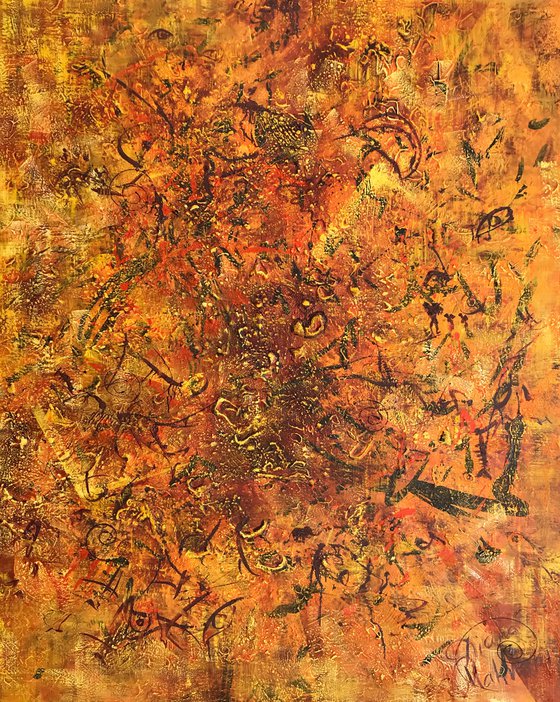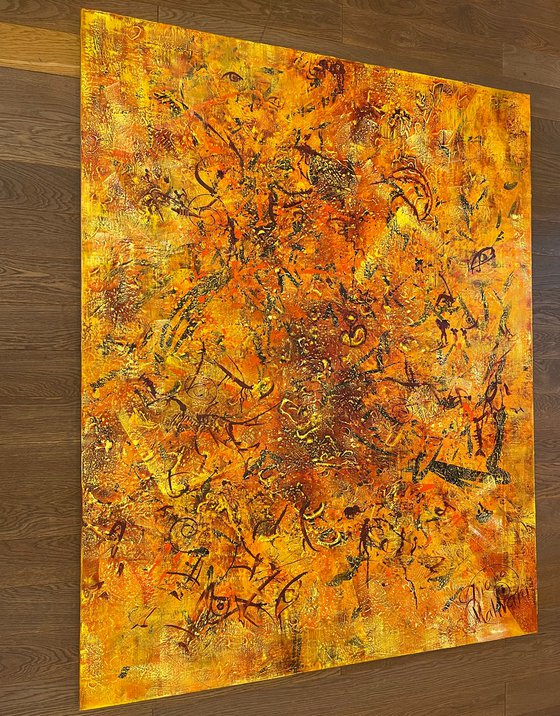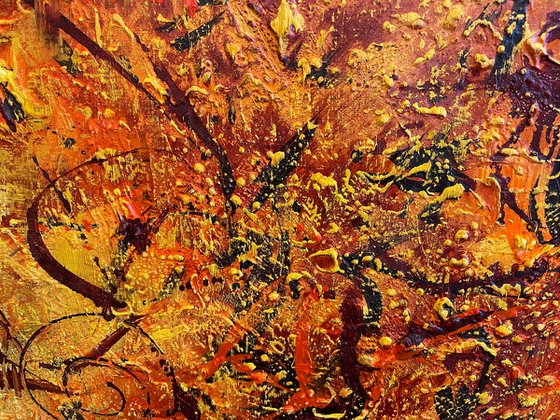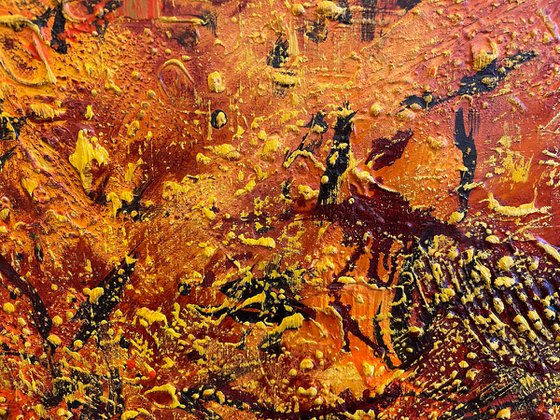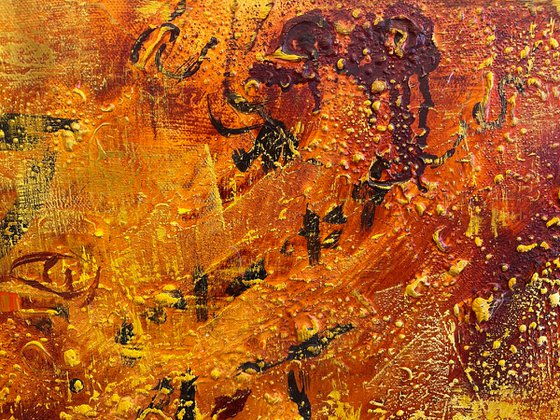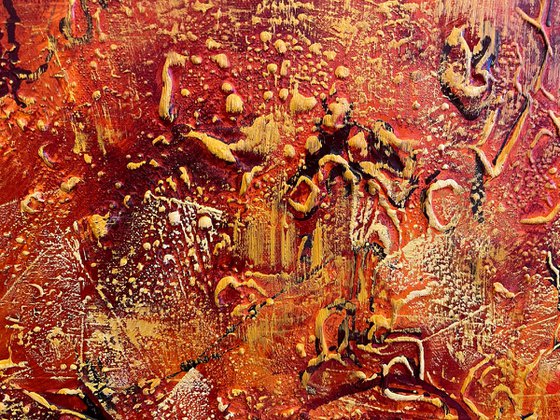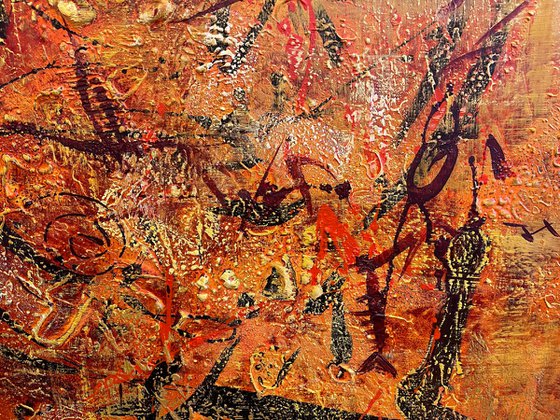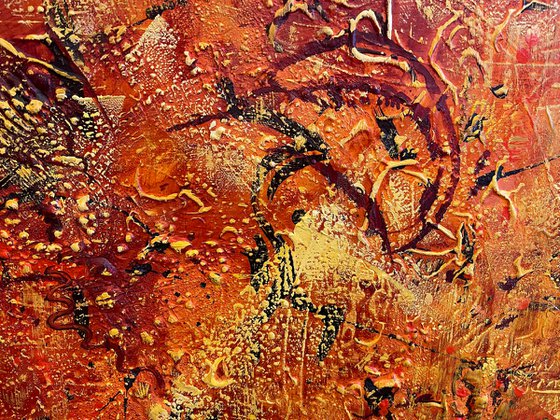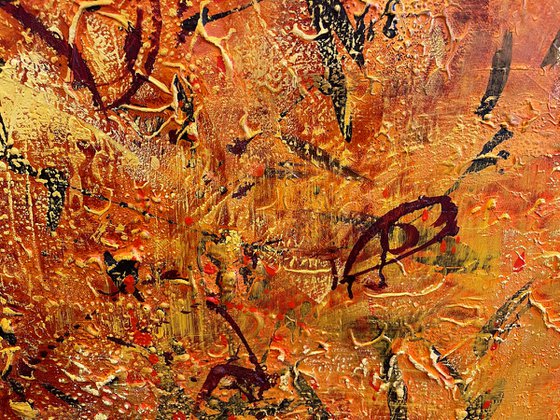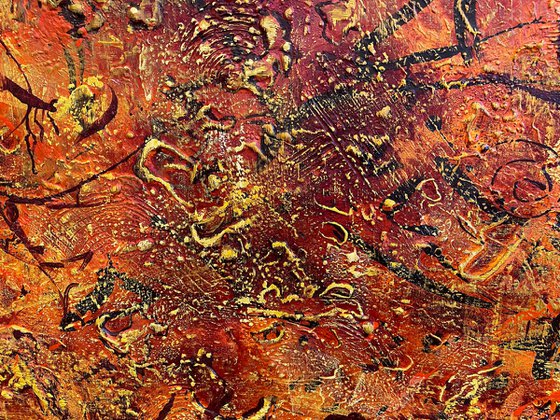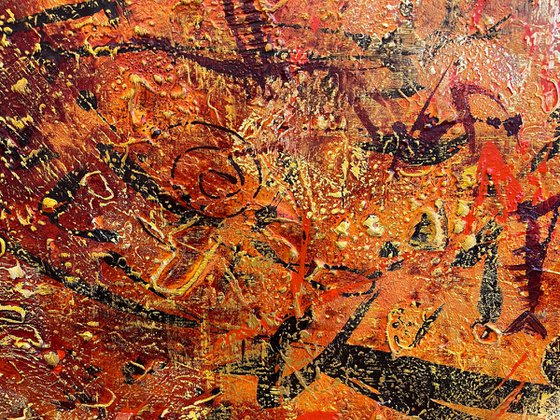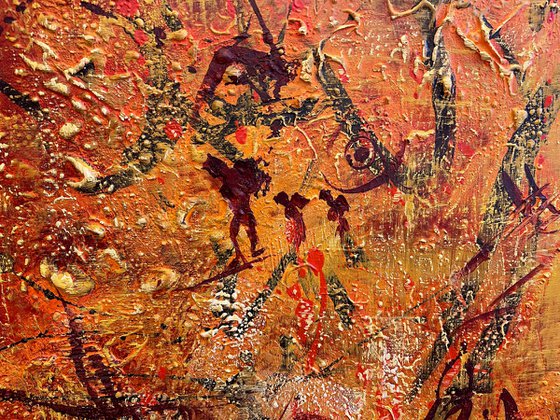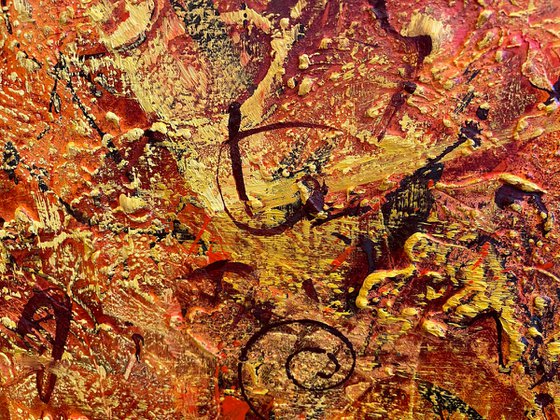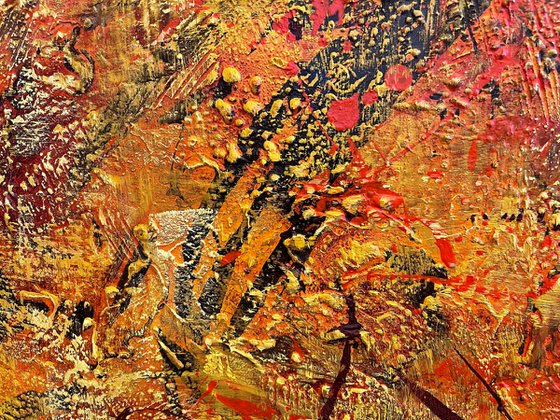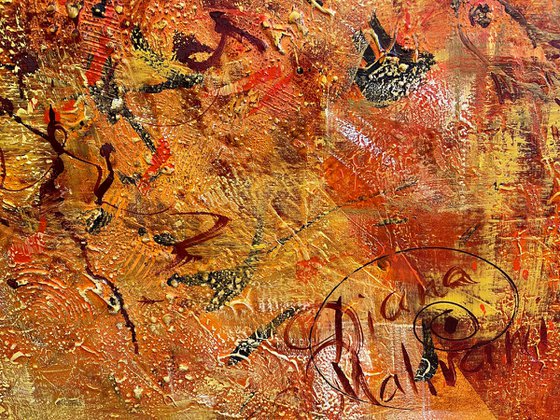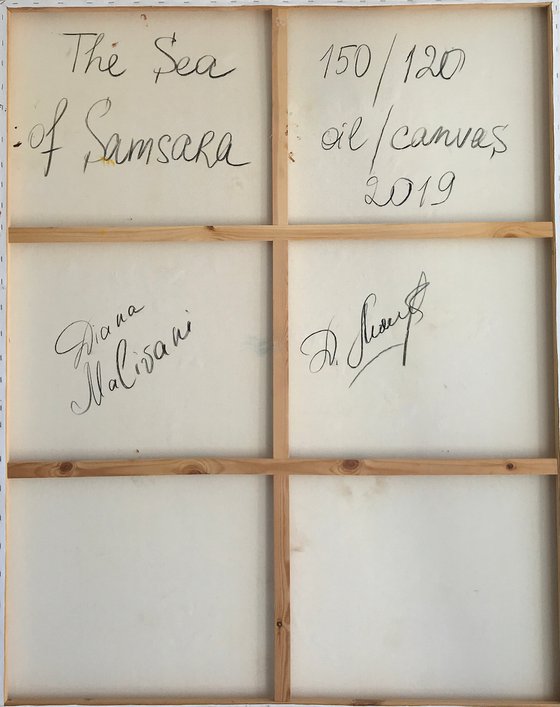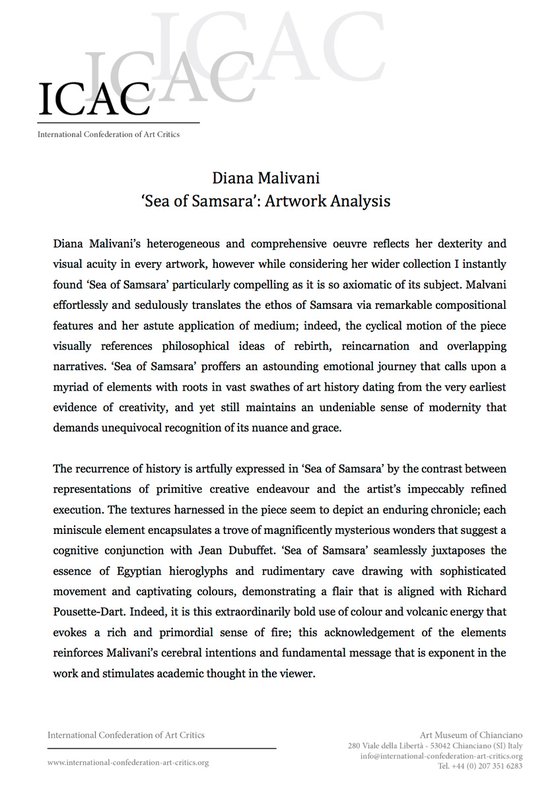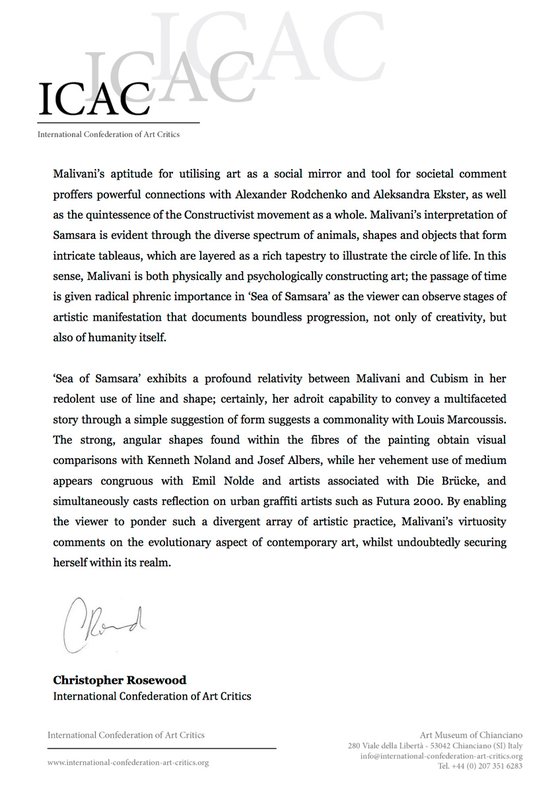- By medium
- By subject
- By budget
- Sales
- Gift cards
- Discover all art
- Artists
- Editors’ picks
- Ideas
Original artwork description:
This artwork had deserved critical analysis by Christopher Rosewood, Art Critic, Member of the ICAC - International Confederation of Art Critics (London, UK and Chianciano, Italy).
* * *
«Diana Malivani’s heterogeneous and comprehensive oeuvre reflects her dexterity and visual acuity in every artwork, however while considering her wider collection I instantly found ‘Sea of Samsara’ particularly compelling as it is so axiomatic of its subject. Malvani effortlessly and sedulously translates the ethos of Samsara via remarkable compositional features and her astute application of medium; indeed, the cyclical motion of the piece visually references philosophical ideas of rebirth, reincarnation and overlapping narratives. ‘Sea of Samsara’ proffers an astounding emotional journey that calls upon a myriad of elements with roots in vast swathes of art history dating from the very earliest evidence of creativity, and yet still maintains an undeniable sense of modernity that demands unequivocal recognition of its nuance and grace.
The recurrence of history is artfully expressed in ‘Sea of Samsara’ by the contrast between representations of primitive creative endeavour and the artist’s impeccably refined execution. The textures harnessed in the piece seem to depict an enduring chronicle; each miniscule element encapsulates a trove of magnificently mysterious wonders that suggest a cognitive conjunction with Jean Dubuffet. ‘Sea of Samsara’ seamlessly juxtaposes the essence of Egyptian hieroglyphs and rudimentary cave drawing with sophisticated movement and captivating colours, demonstrating a flair that is aligned with Richard Pousette-Dart. Indeed, it is this extraordinarily bold use of colour and volcanic energy that evokes a rich and primordial sense of fire; this acknowledgement of the elements reinforces Malivani’s cerebral intentions and fundamental message that is exponent in the work and stimulates academic thought in the viewer.
Malivani’s aptitude for utilising art as a social mirror and tool for societal comment proffers powerful connections with Alexander Rodchenko and Aleksandra Ekster, as well as the quintessence of the Constructivist movement as a whole. Malivani’s interpretation of Samsara is evident through the diverse spectrum of animals, shapes and objects that form intricate tableaus, which are layered as a rich tapestry to illustrate the circle of life. In this sense, Malivani is both physically and psychologically constructing art; the passage of time is given radical phrenic importance in ‘Sea of Samsara’ as the viewer can observe stages of artistic manifestation that documents boundless progression, not only of creativity, but also of humanity itself.
‘Sea of Samsara’ exhibits a profound relativity between Malivani and Cubism in her redolent use of line and shape; certainly, her adroit capability to convey a multifaceted story through a simple suggestion of form suggests a commonality with Louis Marcoussis. The strong, angular shapes found within the fibres of the painting obtain visual comparisons with Kenneth Noland and Josef Albers, while her vehement use of medium appears congruous with Emil Nolde and artists associated with Die Brucke, and simultaneously casts reflection on urban graffiti artists such as Futura 2000. By enabling the viewer to ponder such a divergent array of artistic practice, Malivani’s virtuosity comments on the evolutionary aspect of contemporary art, whilst undoubtedly securing herself within its realm».
«Diana Malivani. «The Sea of Samsara». Artwork Analysis» by Christopher Rosewood, Art Critic, 2019 (ICAC - the International Confederation of Art Critics. London, UK and Chianciano, Italy)
* * *
The name of the artwork, «The Sea of Samsara», deals with Indian philosophical and religious traditions and means the endless ocean we must cross, lifetime after lifetime, to reach that far distant shore, termed in Buddhism Nirvana. Samsṃ ara is a Sanskrit word that means «wandering» or «world», with the connotation of cyclic, circuitous change. It also refers to the concept of cyclicality of all life, of death and rebirth, a fundamental assumption of most Indian religions.
* * *
This artwork is part of the Art Project «Seeing The Invisible».
We can hardly see the invisible; for example, those children’s puzzles which have objects hidden in a picture. We saw none of these things until we really began searching for them in unlikely places. They had been invisible to us, but before long we began to see the invisible.
In her book «Exploring the Invisible: Art, Science, and the Spiritual», Lynn Gamwell shows how modern science has transformed modern art and reveals that the world beyond the naked eye - made visible by advances in science - has been a major inspiration for artists ever since.
In his book «Seeing the Invisible», Michel Henry uncovers the philosophical significance of Wassily Kandinsky’s revolution in painting: that abstract art reveals the invisible essence of life and overturns our conceptions about art, because it seeks to express the internal aspect of phenomena, in other words, to paint the invisible.
* * *
INTERNATIONAL SHIPPING AND CUSTOMS POLICY
All the original artworks are in perfect condition, finished with special protective varnish, carefully and securely packed and ready to hang. The artworks come with a Certificate of Authenticity issued by GWR Art Gallery (Cyprus, EU).
Artist Diana Malivani and GWR Art Gallery offer to the collectors FREE WORLDWIDE SHIPPING by express mail (DHL), with a tracking number.
The artworks are delivered to the collectors on DAP Terms (Delivered At Place), in accordance with Incoterms rules. Customs and import charges are not included in the price. The collector’s order may be subject to import duties and taxes which are applied when the delivery reaches the destination. The collector will be responsible for the payment of any such import duties and taxes. The collector is kindly asked to contact the local customs office for further information before placing the order.
Materials used:
oil, modelling paste
Tags:
#abstract art #contemporary abstract painting #oriental #religious #diana malivani #buddhism #philosophical #samsaraThe Sea of Samsara (2019)
Oil painting
by Diana Malivani
4 Artist Reviews
£45,661
- Oil painting on Canvas
- One of a kind artwork
- Size: 120 x 150 x 4cm (unframed) / 120 x 150cm (actual image size)
- Ready to hang
- Signed on the front
- Style: Abstract
- Subject: Abstract and non-figurative
Original artwork description
This artwork had deserved critical analysis by Christopher Rosewood, Art Critic, Member of the ICAC - International Confederation of Art Critics (London, UK and Chianciano, Italy).
* * *
«Diana Malivani’s heterogeneous and comprehensive oeuvre reflects her dexterity and visual acuity in every artwork, however while considering her wider collection I instantly found ‘Sea of Samsara’ particularly compelling as it is so axiomatic of its subject. Malvani effortlessly and sedulously translates the ethos of Samsara via remarkable compositional features and her astute application of medium; indeed, the cyclical motion of the piece visually references philosophical ideas of rebirth, reincarnation and overlapping narratives. ‘Sea of Samsara’ proffers an astounding emotional journey that calls upon a myriad of elements with roots in vast swathes of art history dating from the very earliest evidence of creativity, and yet still maintains an undeniable sense of modernity that demands unequivocal recognition of its nuance and grace.
The recurrence of history is artfully expressed in ‘Sea of Samsara’ by the contrast between representations of primitive creative endeavour and the artist’s impeccably refined execution. The textures harnessed in the piece seem to depict an enduring chronicle; each miniscule element encapsulates a trove of magnificently mysterious wonders that suggest a cognitive conjunction with Jean Dubuffet. ‘Sea of Samsara’ seamlessly juxtaposes the essence of Egyptian hieroglyphs and rudimentary cave drawing with sophisticated movement and captivating colours, demonstrating a flair that is aligned with Richard Pousette-Dart. Indeed, it is this extraordinarily bold use of colour and volcanic energy that evokes a rich and primordial sense of fire; this acknowledgement of the elements reinforces Malivani’s cerebral intentions and fundamental message that is exponent in the work and stimulates academic thought in the viewer.
Malivani’s aptitude for utilising art as a social mirror and tool for societal comment proffers powerful connections with Alexander Rodchenko and Aleksandra Ekster, as well as the quintessence of the Constructivist movement as a whole. Malivani’s interpretation of Samsara is evident through the diverse spectrum of animals, shapes and objects that form intricate tableaus, which are layered as a rich tapestry to illustrate the circle of life. In this sense, Malivani is both physically and psychologically constructing art; the passage of time is given radical phrenic importance in ‘Sea of Samsara’ as the viewer can observe stages of artistic manifestation that documents boundless progression, not only of creativity, but also of humanity itself.
‘Sea of Samsara’ exhibits a profound relativity between Malivani and Cubism in her redolent use of line and shape; certainly, her adroit capability to convey a multifaceted story through a simple suggestion of form suggests a commonality with Louis Marcoussis. The strong, angular shapes found within the fibres of the painting obtain visual comparisons with Kenneth Noland and Josef Albers, while her vehement use of medium appears congruous with Emil Nolde and artists associated with Die Brucke, and simultaneously casts reflection on urban graffiti artists such as Futura 2000. By enabling the viewer to ponder such a divergent array of artistic practice, Malivani’s virtuosity comments on the evolutionary aspect of contemporary art, whilst undoubtedly securing herself within its realm».
«Diana Malivani. «The Sea of Samsara». Artwork Analysis» by Christopher Rosewood, Art Critic, 2019 (ICAC - the International Confederation of Art Critics. London, UK and Chianciano, Italy)
* * *
The name of the artwork, «The Sea of Samsara», deals with Indian philosophical and religious traditions and means the endless ocean we must cross, lifetime after lifetime, to reach that far distant shore, termed in Buddhism Nirvana. Samsṃ ara is a Sanskrit word that means «wandering» or «world», with the connotation of cyclic, circuitous change. It also refers to the concept of cyclicality of all life, of death and rebirth, a fundamental assumption of most Indian religions.
* * *
This artwork is part of the Art Project «Seeing The Invisible».
We can hardly see the invisible; for example, those children’s puzzles which have objects hidden in a picture. We saw none of these things until we really began searching for them in unlikely places. They had been invisible to us, but before long we began to see the invisible.
In her book «Exploring the Invisible: Art, Science, and the Spiritual», Lynn Gamwell shows how modern science has transformed modern art and reveals that the world beyond the naked eye - made visible by advances in science - has been a major inspiration for artists ever since.
In his book «Seeing the Invisible», Michel Henry uncovers the philosophical significance of Wassily Kandinsky’s revolution in painting: that abstract art reveals the invisible essence of life and overturns our conceptions about art, because it seeks to express the internal aspect of phenomena, in other words, to paint the invisible.
* * *
INTERNATIONAL SHIPPING AND CUSTOMS POLICY
All the original artworks are in perfect condition, finished with special protective varnish, carefully and securely packed and ready to hang. The artworks come with a Certificate of Authenticity issued by GWR Art Gallery (Cyprus, EU).
Artist Diana Malivani and GWR Art Gallery offer to the collectors FREE WORLDWIDE SHIPPING by express mail (DHL), with a tracking number.
The artworks are delivered to the collectors on DAP Terms (Delivered At Place), in accordance with Incoterms rules. Customs and import charges are not included in the price. The collector’s order may be subject to import duties and taxes which are applied when the delivery reaches the destination. The collector will be responsible for the payment of any such import duties and taxes. The collector is kindly asked to contact the local customs office for further information before placing the order.
Materials used:
oil, modelling paste
Tags:
#abstract art #contemporary abstract painting #oriental #religious #diana malivani #buddhism #philosophical #samsara14 day money back guaranteeLearn more
